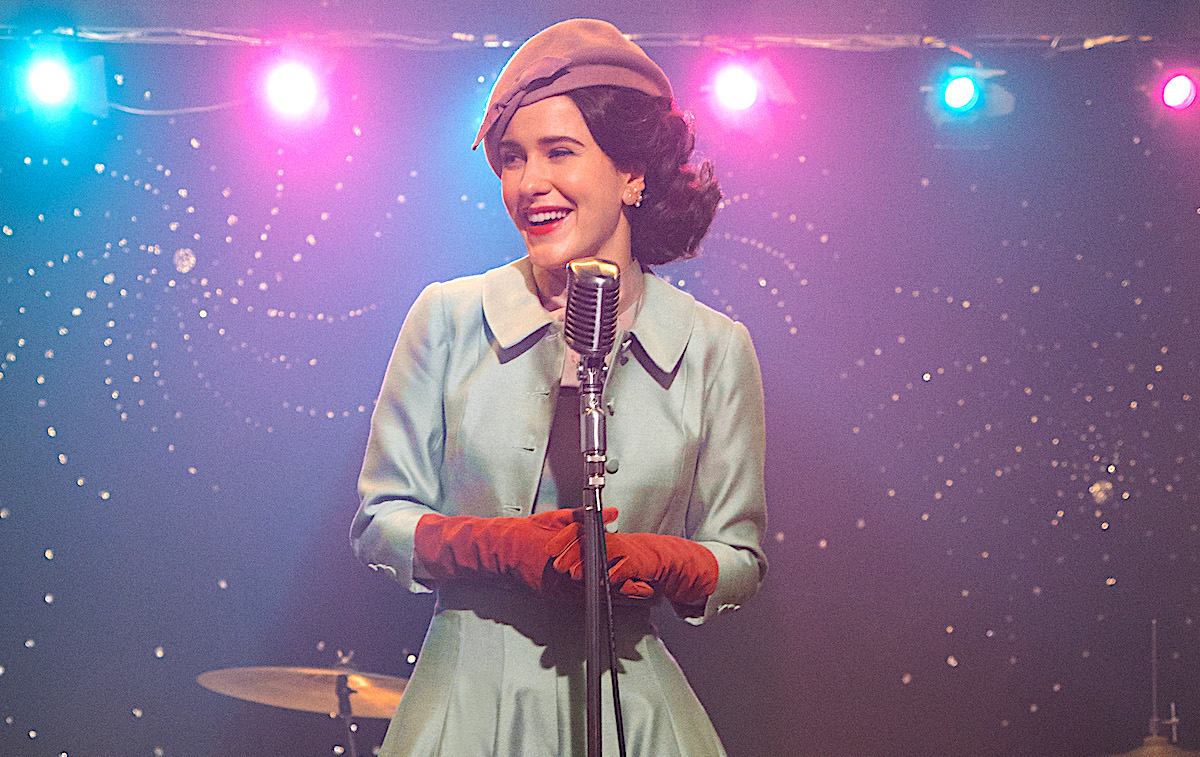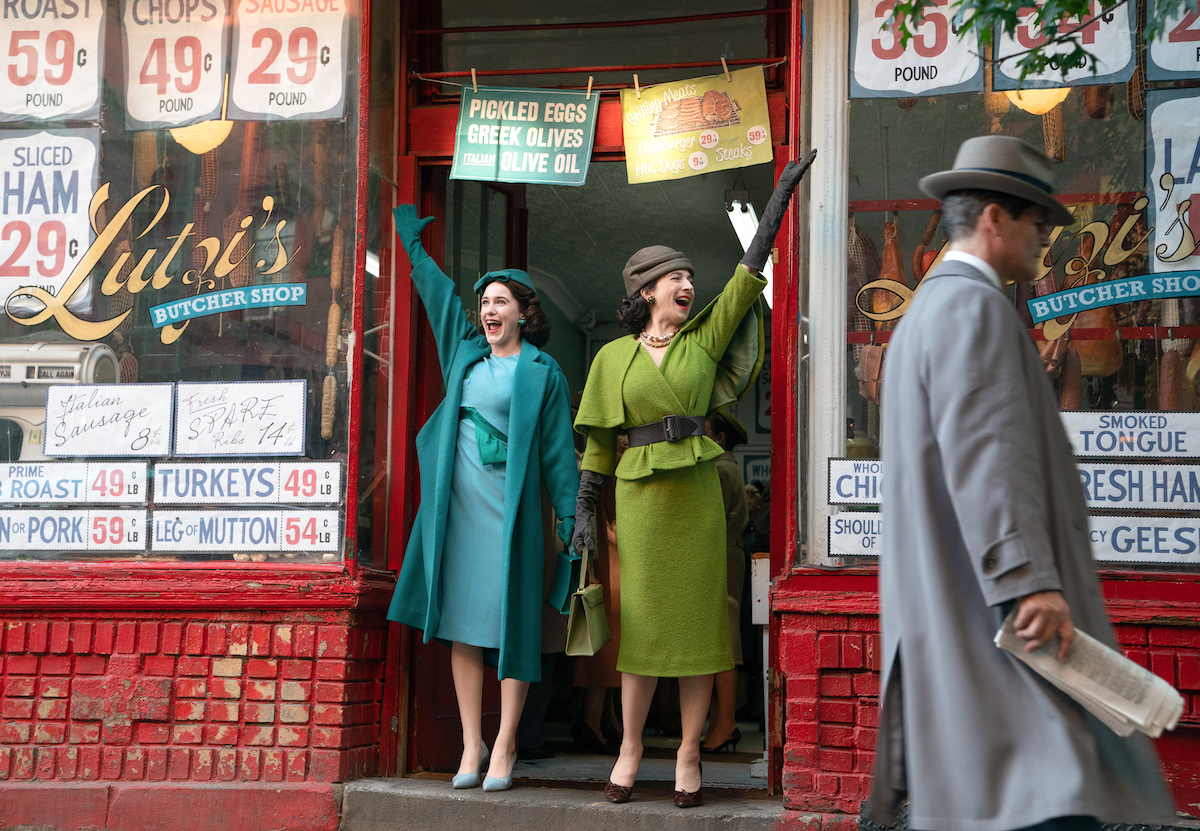
And a whole bunch of Emmys, too! The Marvelous Mrs. Maisel begins Season 2 as one of the most critically touted shows in TV history thanks to a tight creative team that values union labor.
Regardless of whether you watch on your phone, tablet or large-screen LED display, The Marvelous Mrs. Maisel feels big: like a major cinematic work. Or, as co-DP David Mullen, ASC (who received an ASC Award nomination for the pilot) describes: “With some people watching in 4K HDR on 60-inch monitors and others watching on a smartphone, you can’t choose a shot size or composition based on the unknown dimensions of the display.”
“So,” adds Maisel co-DP Eric Moynier, “we look at shooting this series as home cinema. We don’t think about the size of the screen, we think about how the shot will help tell the story and achieve the look that David and Amy created for the pilot.”
“Amy,” of course, is Amy Sherman-Palladino, who, along with husband Dan Palladino, forms Maisel’s show-running team. Both are Emmy-winning producers, with show creator Amy Sherman-Palladino also winning for directing and writing, the latter aided by whip-smart dialog that helps to establish the pace and energy of the camera coverage. And as 2ndAC Cornelia Klapper observes: “Unlike other comedy shows, the camera plays an active role. Movements are choreographed and precise, supporting and emphasizing the energy of the actors. Often the camera move becomes an active participant in the scene.”
Now entering its second season, after a spectacular Amazon streaming debut that included eight Emmy awards and two Golden Globes, The Marvelous Mrs. Maisel centers on a 1950s New York City housewife playing along with her husband’s hobby: stand-up comedy. The relationship unexpectedly goes south, and Miriam “Midge” Maisel (the marvelous one), reeling from betrayal and a little bit drunk, heads off to the club and inadvertently finds herself in the spotlight. In comedy parlance, she kills.
Season 1, which followed Midge through the ups and downs of being a young divorcée and a rising female comic (when there weren’t any), has departed from the comedic playbook in ways beyond just camera movement; i.e., it’s primarily a single-camera production.
As Moynier asserts: “We’ll never compromise the look of the show with a second camera. If lighting is right, we may use two cameras for cross coverage, but that’s it. And we’re not lensing close-ups with 50 or 75 millimeter – we will use a 30 millimeter. If we’re doing a single on Midge [played by Rachel Brosnahan] or Susie [Myerson, played by Alex Borstein], it will be clean with a tight eyeline.”
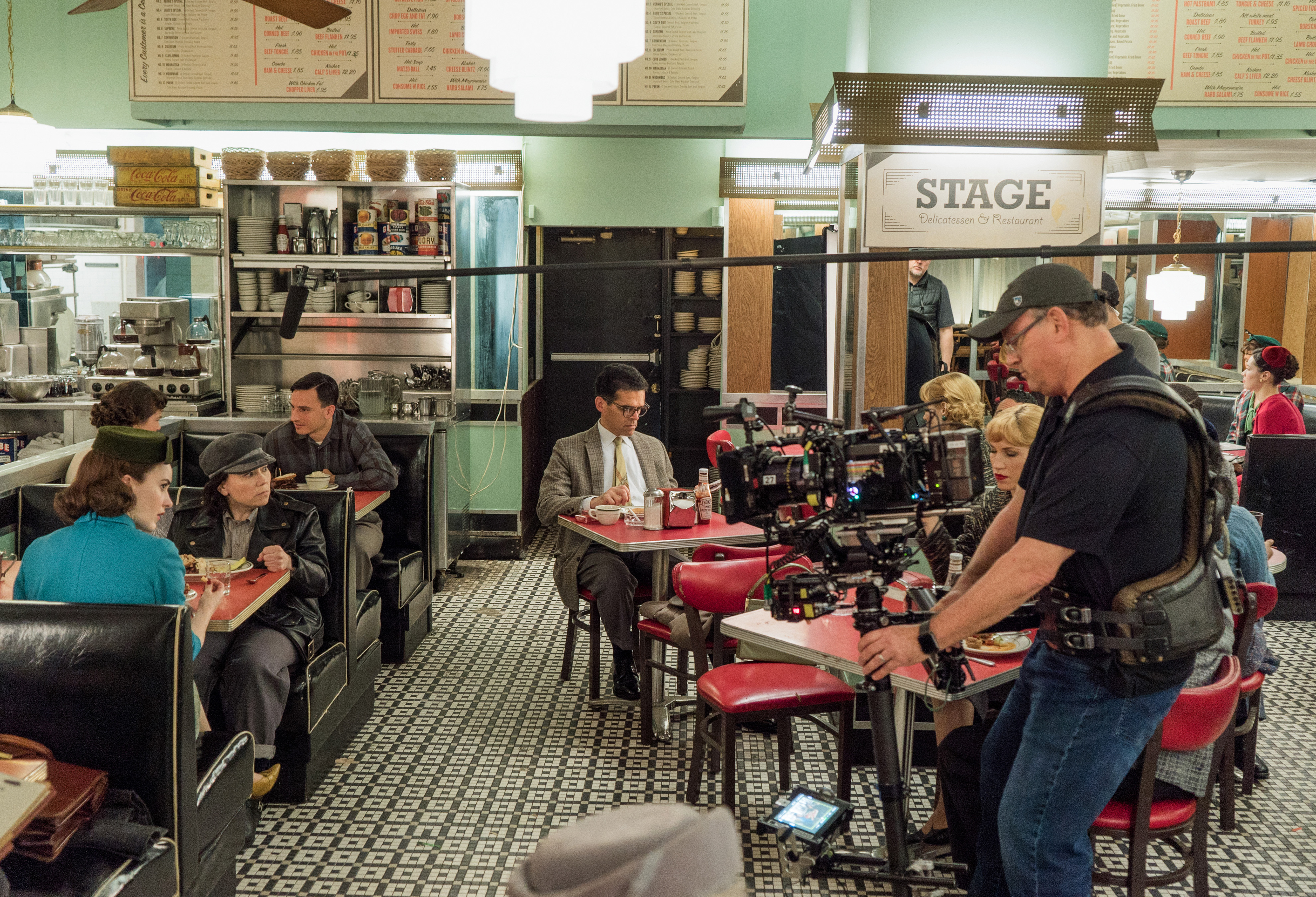
In fact, Mullen and Moynier never shoot close-ups and rarely shoot insert shots.
“Once or twice,” Mullen recalls, “when we had a shot with some text on a notecard or small sign that had to be read by the viewer, we’ve had to sharpen and add some contrast to the lettering in post to make it more legible, rather than shoot it tight.” The DP’s also try to separate characters from the background at key moments with careful lighting and depth of field. “Sometimes if I find the background too busy behind the actors’ heads in an intimate dialogue scene, I’ll open up the lens iris from our usual f/2.8 to an f/2.0 to soften the background at that moment,” Mullen adds.
Stylistic continuity has been seamless. “Eric and I match each other’s lighting and the look created from the start, and we have [A- Camera/Steadicam Operator] Jim McConkey [SOC] on every episode to keep the moving camera and framing style consistent,” Mullen continues. “The main time when we really have to coordinate with each other is when a new set is built, and the permanent lighting installed has to work for both of us and the potential needs of the scripts down the road.”
“The biggest challenge in season one,” describes Gaffer John Oates, “was coordinating the lighting cues with the camera. My dimmer board operator, Scott Maher, was very proactive to head off potential problems.” Close collaboration with Production Designer Bill Groom and his art department ensures that practical lighting does a lot of the work illuminating the actors, particularly, Mullen says, “since we often do elaborate camera moves, sometimes 360s, which make it hard to add any movie lighting. I’m proud when I light a scene that looks natural and is still flattering for the cast, and yet allows unrestricted camera movement. It’s what most cinematographers hope to achieve!”
McConkey says he gets an assist from the Artemis Prime video viewfinder, which he sets to the scene’s lens and camera package. He then puts the lens on the iPad and choreographs shots with Sherman-Palladino. “After rehearsal, but before we bring in the rest of the crew, Amy stands behind me and I use the finder to see what she’s seeing,” McConkey shares. “Then she literally pushes me around to track the shot. I know when she’s got a wild idea because she gets a mischievous look. She’ll say, ‘Can you spin around?’ and then David or Eric and I will try to figure out a way to make that happen. That’s how we discover the emotional center she wants for the shot.”
They make temporary marks, and by the time rehearsals for official marks roll around, McConkey has the moves figured out and recorded on his iPad. After a couple of run-throughs, he can show the DP’s where they are able to place lights. “It’s instantaneous,” he says. “That’s why we can do complicated scenes in a way that’s creatively and emotionally quicker than traditional situations.”
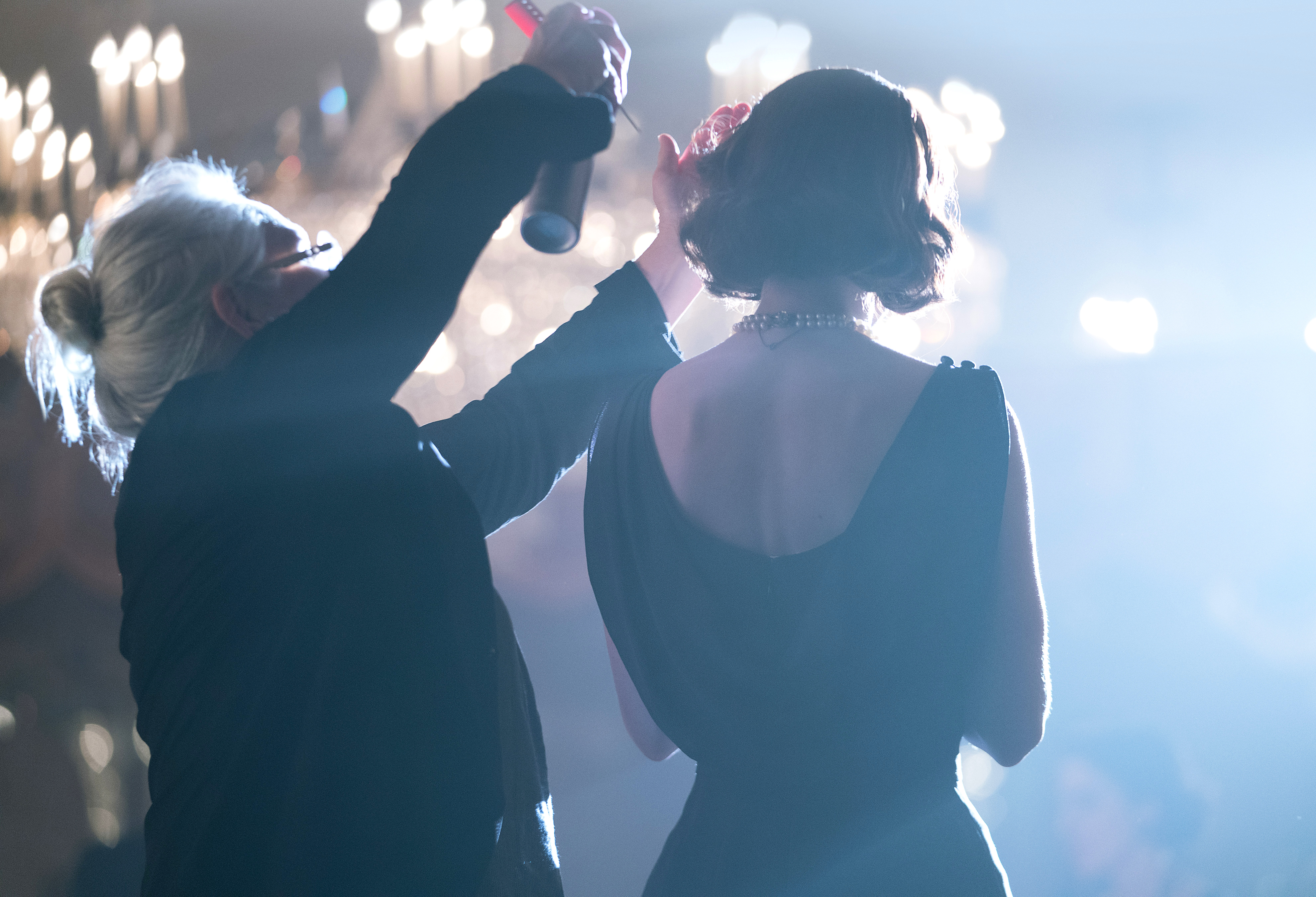
One such example was a flashback montage Mullen shot for Episode 4. It starts at a nighttime New Year Eve’s party and moves from the dining room into the living room, rotates around Midge, and then transitions in halfway through a second 360 to a daytime interior of the same living room now empty except for Midge, and then moves back to the dining room into a wide shot.
“Amy wanted the transition as seamless as possible rather than using a traditional dissolve,” Mullen recalls. “Knowing that our visual effects supervisor, Lesley Robson-Foster, would have to do some morphing to hide the transition, we had to make sure the background behind Midge would be the same in both versions and that her hair and wardrobe wouldn’t be too different. We didn’t want a collar or a sleeve to disappear or appear on her during the transition. I had to light [Brosnahan] with an overhead source that stayed on during both versions, though in the transition to daytime the soft ambient window light naturally floods onto her as an additional source.”
Mullen shot the scene on a 21-mm lens (instead of the show’s typical 24 mm), so Robson-Foster had some flexibility to zoom into the frame and reposition elements to make the two passes line up exactly. “In the end,” Mullen reports, “Lesley still had to combine elements from both passes to get everything to line up at the moment of transition.”
Traditionally this sequence would be produced with a motion-control rig, but the semi-spiral movement couldn’t be done on a track. Jim McConkey practiced the “figure 9” move by having playback feed an overlay of the party sequence on his Steadicam monitor, enabling him to match distance and lens height as closely as possible. He used Betz-Tools Wave1 to stabilize the horizon so he could focus on framing and choreography without worrying about being off level.
Another complex and iconic oner in the inaugural season was a four-minute sequence in the Copacabana club, shot at a carefully redesigned Masonic Temple in Brooklyn. It begins close on a drummer on stage, flies through the band and pulls further back to reveal people dancing, and sitting at tables. Then it lowers to crowd level, following a waiter through the room and into the kitchen, where there’re about two minutes of dialog between Midge and Susie, captured in a 360.
They knew the shot would require a crane, a MōVI and some kind of electromagnetic release system to continue action into the kitchen. “That’s when I called [older brother] Larry,” Jim McConkey remembers. The elder McConkey, part mad scientist, part master mechanic (and co-inventor of the SkyCam), had already used a mechanical quick-release system for a Luc Besson film but decided the shot needed something “slicker” and designed a system specifically for this shot. After a few days of tinkering, he had the solution: a new rig using an electromagnet with a 20-pound weight that would free the camera from the 50-foot Technocrane and “mount” it on the operator.
“Charlie [Sherron, Key Grip] had to figure out how to take the safety off so the camera didn’t fall by mistake, and the grips contracted the arm as Larry, wearing the Armor Man, walked in,” Jim McConkey recalls. “They had to pull down on the crane while he was pushing up to take out the ‘drop’ and hide the transition while I was on the wheels. We think that was the first time this technique has been done.”
First AC Anthony Cappello describes the controlled chaos: “We had literally everyone from the AD department choreographing background, the grip department on crane, the lighting department coordinating cues to avoid camera shadows, dancers avoiding bumping into the camera, and our operators – Jimmy on the wheels, Larry carrying the Mōvi – coordinating all the difficult moves, while I had the multiple focusing challenges.
“Everyone had to be on point, or you would have a collision or make a mistake that would require us to start all over. I believe it took 21 takes total. It’s an impressive shot – a big movie shot – pulled off on a weekly series. We’re all very proud of it.”
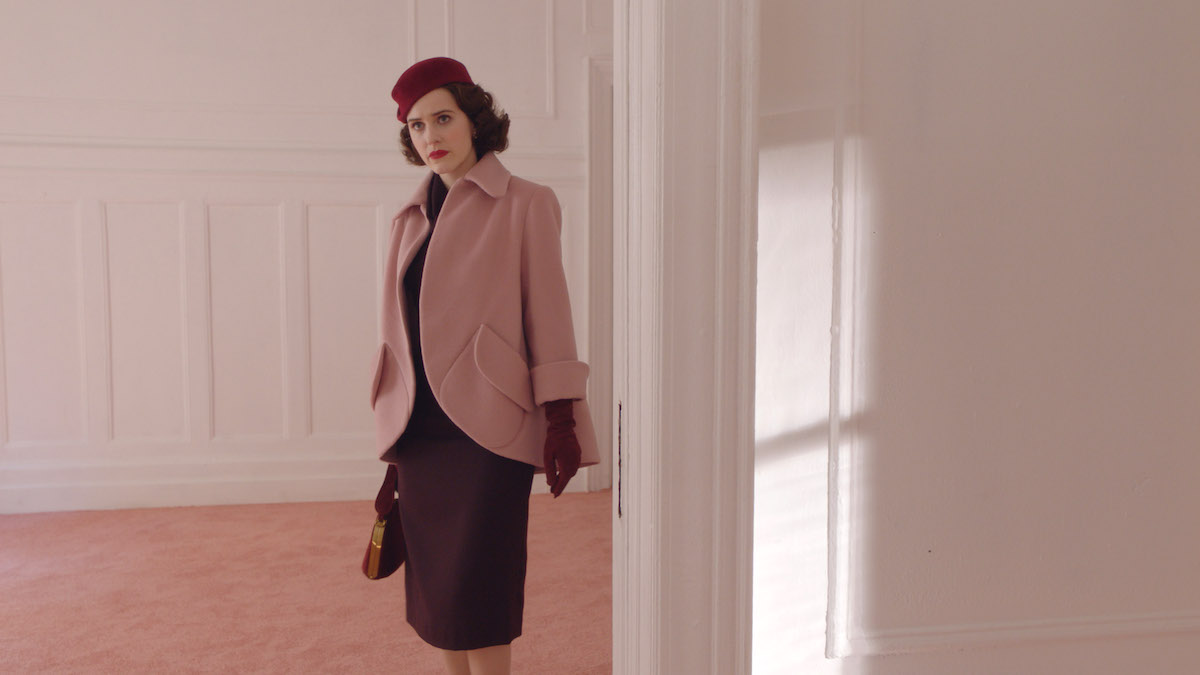
Adding to the visual magic is an authentic late 1950s look and feel created by Bill Groom’s detailed production design and Donna Zakowska’s equally scrupulous and creative costume design (which earned an Emmy nomination). Groom and set designer Ellen Christiansen know how to deliver shootable sets that were almost 360, so as not to restrain Sherman-Palladino’s love of long takes, or Mullen and Moynier’s ability to deliver that vision. “The details and the palette are everywhere I point the camera,” Moynier says. Adds Mullen: “What Eric and I do is try to find opportunities to naturally bring in some colored lighting now and then, perhaps some red neon lighting in a bar scene.”
Sequences shot outside in modern-day New York require some thought, given the 180- and 360-degree shots that have become part of the series’ visual language. Sometimes the solution to staying “on period” is low-tech, like blocking reflections in car or building windows or hiding modern elements behind period delivery trucks or busses. Other times, a little assist from post is required.
The wardrobe – and how it appears on screen – revels in the late-1950s era in which the story unfolds. As Mullen describes: “In the movies of that period you often see the lead actress walk into a grey or brown room wearing a dress or coat in a striking color that pops from the background.” He calls this color aesthetic “aggressively pastel” because it features a strong color accent framed against neutral tones.
“David and I both enjoy working with color and make a lot of references to Kodacolor when we’re searching for a hue, like that certain red or certain green,” Zakowska shares. “He’s very supportive of my use of color in what he can photograph. You can create great costumes, but they have to work with the cinematography, whether it’s digital or film.”
To keep all that color palette consistent is DIT Charlie Anderson, who says Mullen and Moynier both make on-set color management a priority. “I’m primarily doing color matching between cameras,” Anderson relates. “My main goal is to match the wide or the first shot in the series, whichever comes first, pulling iris when needed.” David Mullen does as much color and lighting work in-camera as possible, “so I’m mainly matching color. He does his own stop pulls, also, unless there’s a need for both cameras to do one.”
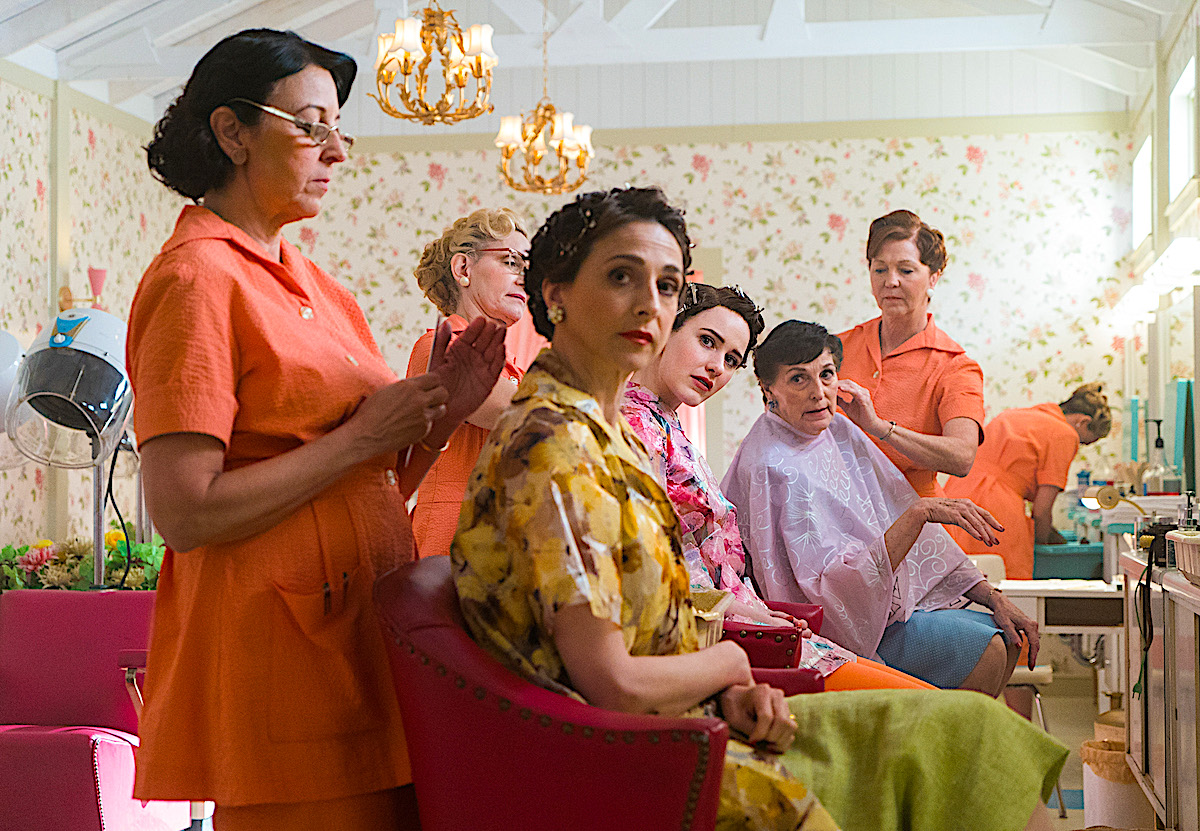
Anderson checks in with dailies colorist Aaron Burns and Light Iron Supervising Colorist Steven Bodner almost daily about the prior and current day’s work, as well as what’s coming up. “This gives Steven as much info as possible when going into a DI, as he’s working on a time crunch,” Anderson adds. “The more Steven is able to prep and be aware of, the more time he’s able to anticipate certain situations that arise in the final color, especially since we’re doing an HDR master as well.”
“What’s very important about this show is the dedication and commitment. Everyone cares,” Cappello says. “I believe this stems from Amy and Dan, who are there and committed every day, and from our producers Dhana Gilbert, Nick Thomason and Meghan Wicker. They make us feel welcome and a real part of the process. Being committed is easy because it’s a true collaboration.”
The results in a single season speak for themselves: 16 Emmy nominations, including Comedy Series and Outstanding Cinematography for a Single-Camera Series (One Hour), and eight statuettes. Maisel also garnered two Golden Globes in 2018 (Best TV Series – Musical or Comedy, and Best Performance by an Actress in a TV series – Musical or Comedy) and, just recently, another Golden Globe for Brosnahan for Season 2.
“I’ve never been asked by so many other New York AC’s if I could get them on this show, just to work for a day,” laughs Andrea Bias, B-Camera 2ndAC for Season 2. “Maisel is shot like a feature film. I feel very proud to be a part of such meticulously crafted work.”
For Mullen and Moynier, the success of The Marvelous Mrs. Maisel is derived from true creative cohesion. “Amy and Dan’s writing and the performances from our cast really drive this show,” Mullen concludes. “There’s also an aesthetic pleasure from watching the image that the viewer feels, though I think that is mostly due to Donna’s costumes and Bill’s production design, and the whole time-capsule aspect.”
“The ensemble camera team is amazing at logistics, getting things ready and pulling off some challenging shots,” Moynier adds. In fact, Sherman-Palladino made specific mention of the union crew in one of her Emmy acceptance speeches. “They have a great attitude, they’re top-shelf and they bring their A-games,” Moynier continues. “We wouldn’t be able to achieve any of this without them.”
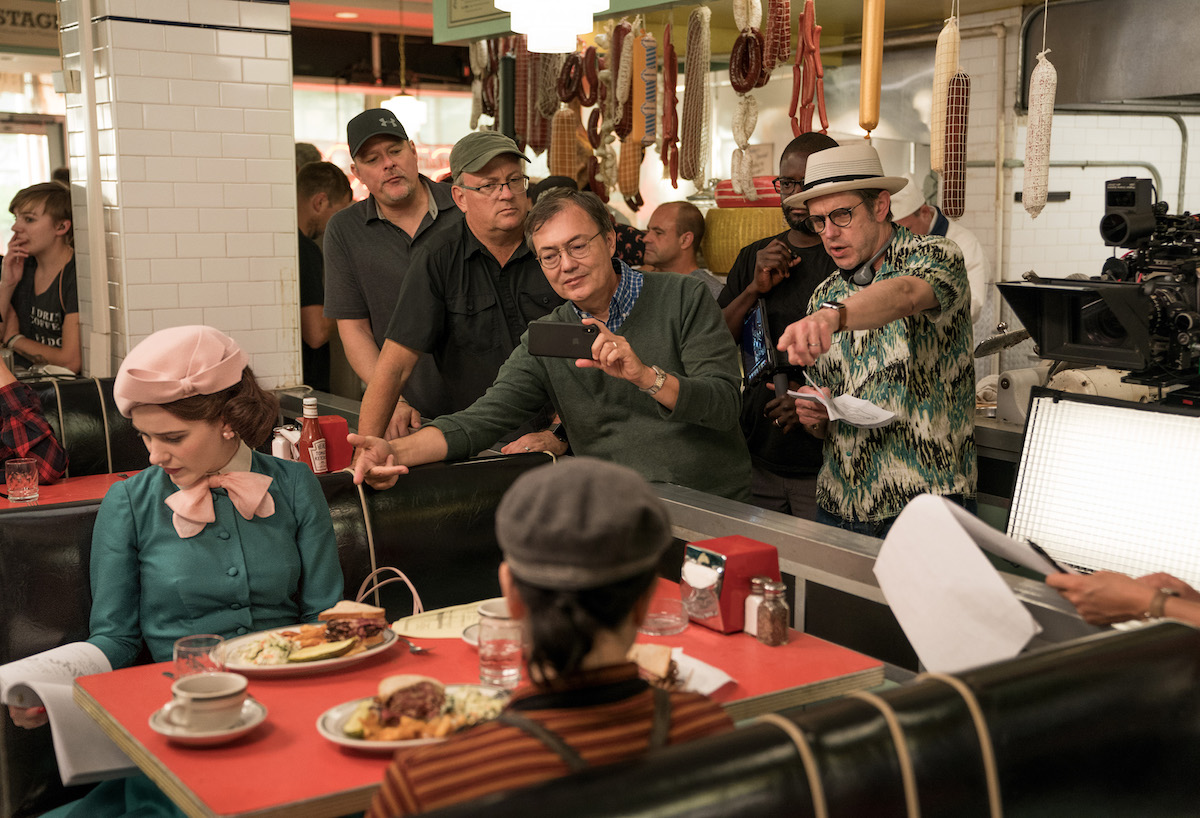
By Margot Lester
Local 600 Crew List
Directors of Photography: M. David Mullen, ASC, Eric Moynier
A-Camera Operator/Steadicam: Jim McConkey, SOC
A-Camera 1st AC: A. Anthony Cappello
A-Camera 2nd AC: Kellon Innocent
B-Camera Operator: Greg Principato
B-Camera 1st AC: Rossana Rizzo
B-Camera 2nd AC: Andrea Bias
DIT: Charlie Anderson
Loader: James Dean Drummond
Still Photographer: Nicole Rivelli
